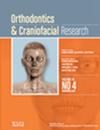Effect of attachment configuration and trim line design on the force system of orthodontic aligners: A finite element study on the upper central incisor
Abstract
Objectives
To use the finite element method (FEM) to investigate the effect of various attachment configurations and trimming line designs of orthodontic aligners on their biomechanical performance.
Method
A 3D upper jaw model was imported into 3D design software. The upper right central incisor tooth (Tooth 11) was made mobile, and its periodontal ligament (PDL) and bone structures were designed. Aligners were modelled with three distinct attachment configurations: No attachment, rectangular horizontal, rectangular vertical, and two trimming line designs; scalloped and straight extended, with a homogeneous thickness of 0.6 mm. These models were then imported into an FE software. Simulations were conducted for three different movements, including facial translation, distalization, and extrusion.
Results
Forces were recorded at 1.3–2.6 N during facial translation, 1.4–5.9 N in distalization, and 0.0–2.0 N in extrusion. The straight extended trimming line consistently generated higher forces than the scalloped design. Attachments had no significant impact on force components during facial translation but were more effective in distalization and extrusion. The combination of a straight extended trimming line with horizontal attachments exhibited the least stresses at the apical third during distalization, and the highest stresses during extrusion, suggesting superior retention.
Conclusions
Rectangular attachments offer limited benefits in facial translation, but horizontal rectangular attachments can intensify load in distalization and are crucial for force generation in extrusion. Horizontal attachments are preferred over vertical options. Additionally, the straight extended trim line enhances control of tooth movement and can replace attachments in certain cases.
Clinical Relevance
These findings provide biomechanical evidence and an optimal protocol to guide clinical practice in planning diverse teeth movements. The emphasis is on the influence of attachment utilization and the specific design of aligner trimming lines to enhance control over tooth movement.


 求助内容:
求助内容: 应助结果提醒方式:
应助结果提醒方式:


